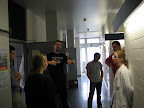Seems ordinary, doesn't it?
Well, not if you spin it around. The rest of the jar:
In case you can't see the writing, due to the lighting in the picture or the gamma of your monitor, it says: "womanish behavior cash." A little backstory: Prof. Wagner and his good friend and colleague, Prof. Holthausen, have this floating cash sum that gets deposited into whenever one of them engages in womanly behavior. This could be for saying something in a particular manner, dressing properly, eating with a knife and fork -- who knows. This jar is simply that tradition or pact taken physical form, and it has become of something of an workgroup joke. When I was asked by Prof. Wagner if the wording on the side was proper, I replied that it was, but would be considered politically incorrect. He replied that therein lies one of the advantages of being in Germany, for "in the old country, you can be politically incorrect." This sentiment is not unique to Prof. Wagner either.
Now, on to why this pertains to me:
1. The pump for my Schlenk apparatus is, in fact, small. Cute, even.
2. My chemistry is quite colorful:
-A white, substituted imidazole deprotonates to form the blue potassium (should I say "kaliates?") salt. The filtrate is also quite blue, but becomes quite pink after awhile.
-Dissolution of this salt in DMF yields a magenta solution that forms similarly colored crystals.
-A colorless diborate liquid combined with the white imidazole and potassium salt forms a reaction mixture that is reminiscent of taro. Sample this with DMF and you get grape juice. Reflux the taro to get pepto-bismol, which the solid product also looks like. This solvated in DMF turns quite rose.
Those annoying color tags should speak for themselves.
This sort of jar would never work in my more politically "correct" home. Not that I would want such a jar in our workgroup, but hypothetically this would especially never work at JSD given how many of the other students and professors are women. I don't think I need to mention Scripps College. I do intend to graduate in one piece, and I don't think that diplomas are awarded posthumously.
Please don't kill me.
